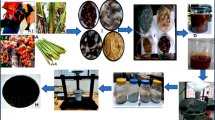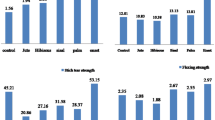Abstract
Worldwide leather industry is known to cause high degree of pollution such as soil and water contamination. Dyed trimming, a leather industry waste, is often dumped near the industrial site and is used for land filling. Recycling of such industrial wastes for making useful products by substituting leather has been investigated and reported here. Flexible composite sheets were made from dyed trimmings only and also in combination with natural fibres in various blend ratios. Wastes from jute and cotton were used as sources of natural fibres. The composite sheets showed maximum tensile strength and breaking loads at 50:50 blend ratios of dyed trimmings and natural fibres. The ultimate tensile strength, elongation, double fold, bursting strength, density and water and oil absorption characteristics of the composite sheets were determined as per American Society for Testing and Materials and Indian Standard methods. The products, i.e. the composite sheets, and the starting materials, i.e. the dyed trimmings and jute and cotton fibres, were also characterized by Fourier transform infrared spectroscopy, thermogravimetric analysis and scanning electron microscopy. Energy-dispersive X-ray analysis of both untreated and treated dyed trimmings was carried out and the presence of chromium 2.54% in untreated samples was recorded but the sample treated with NaOH did not show the presence of chromium. The natural fibre significantly improves the mechanical strength and thermal properties of the blended composite sheets with the increase in flexibility. These flexible sheets possess higher physical strength as compared to leather and may be used as leather substitute for making apparels and goods.
Graphical Abstract




Similar content being viewed by others
References
Ahmad MR, Ahmad WYW, Samsuri A, Salleh J (2007) Ballistic response of natural rubber latex coated and uncoated fabric systems. J Rubber Res 10(4):207–221
Aloy M, Folachier A, Vulliermet B (1976) Tannery and pollution. Centre Technique Du Cuir
Bismarck A, Baltazar-Y-Jimenez A, Sarikakis K (2006) Green composites as panacea? Socio-economic aspects of green materials. Environ Dev Sustain 8(3):445–463
Boopathy R, Karthikeyan S, Mandal AB, Sekaran G (2013) Characterisation and recovery of sodium chloride from salt-laden solid waste generated from leather industry. Clean Technol Environ Policy 15:117–124
Das H, Dutta D, Saikia P, Kalita D, Goswami T (2014) Novel composite materials from polymeric waste and modified agro-fiber. Appl Sci Adv Mater Int 1:3–11
Dutta D, Hazarika R, Dutta PD, Goswami T, Sengupta P, Dutta DK (2016) Synthesis of Ag–Ag2S Janus nanoparticles supported on an environmentally benign cellulose template and their catalytic applications. RSC Adv 6:85173–85181
Eikenberry EF, Brodsky B (1981) X-ray diffraction of reconstituted collagen fibers. J Mol Biol 144:397–404
El-Sabbagh SH, Mohamed OA (2011) Recycling of chrome-tanned leather waste in acrylonitrile butadiene rubber. J Appl Polym Sci 121(2):979–988
Fahim NF, Barsoum BN, Eid AE, Khalil MS (2006) Removal of chromium(III) from tannery wastewater using activated carbon from sugar industrial waste. J Hazard Mater 136(2):303–309
Fidelis MEA, Pereira TVC, Gomes ODFM, Silva FDN, Filho RDT (2013) The effect of fiber morphology on the tensile strength of natural fibers. J Mater Res Technol 2:149–157
Holbery J, Houston D (2006) Natural-fiber-reinforced polymer composites in automotive applications. JOM 58(11):80–86
Horn MM, Martins VCA, Plepis AMD (2009) Interaction of anionic collagen with chitosan: effect on thermal and morphological characteristics. Carbohydr Polym 77:239–243
IS 2712, 1998. Gaskets and packings—compressed asbestos fibre jointing (MED 30: Gaskets and Packing)
Kanagaraj J, Velappan KC, Chandra Babu NK, Sadulla S (2006) Solid wastes generation in the leather industry and its utilization for cleaner environment—a review. J Sci Indus Res 65(7):541–548
Madera-Santana TJ, Tores AC, Lucero AM (1998) Extrusion and mechanical characterization of PVC-leather fiber composites. Polym Compos 19:431–439
Maldas D, Shiraishi N, Maldas D, Shiraishi N (1997) Liquefaction of biomass in the presence of phenol and H2O using alkalies and salts as the catalyst. Biomass Bioenergy 12:273–279
Mirghani MES, Salleh HM, Man YBC, Jaswir I (2012) Rapid authentication of leather and leather products. Adv Nat Appl Sci 6:651–659
Payne KJ, Veis A (2004) FTIR of collagen and gelatine solutions. Biopolymers 27:1749–1760
Puica NM, Pui A, Florescu M (2006) FTIR spectroscopy for the analysis of vegetable-tanned ancient leather. Eur J Sci Theol 2:49–53
Rao JR, Thanikaivelan P, Sreeram KJ, Nair BU (2002) Green route for the utilization of chrome shavings (chromium-containing solid waste) in tanning industry. Environ Sci Technol 36(6):1372–1376
Ray D, Sarkar BK, Basak RK, Rana AK (2002) Study of the thermal behavior of alkali-treated jute fibers. J Appl Polym Sci 85:2594–2599
Reddy N, Yang Y (2005) Biofibers from agricultural byproducts for industrial applications. Trends Biotechnol 23(1):22–27
Rowell RM, Sanadi AR, Caulfield DF, Jacobson RE (1997) Utilization of natural fibers in plastic composites: problems and opportunities. Lignocellulosic-Plastic Compos 13:23–51
Saikia P, Dutta D, Kalita D, Bora JJ, Goswami T (2015) Constr Build Mater 101:1031–1036
Saravanabhavan S, Aravindhan R, Thanikaivelan P, Rao JR, Nair BU (2003) Green solution for tannery pollution: effect of enzyme based lime-free unhairing and fibre opening in combination with pickle-free chrome tanning. Green Chem 5(6):707–714
Segal L, Creely JJ, Martin JAE, Conrad CM (1959) An empirical method for estimating the degree of crystallinity of native cellulose using the X-ray diffract meter. J Text Res 29:786
Senthil R, Hemalatha T, Kumar BS, Uma TS, Das BN, Sastry TP (2015a) Recycling of finished leather waste: a novel approach. Clean Technnol Environ Policy 17:187–197
Senthil R, Inbasekaran S, Gobi N, Das BN, Sastry TP (2015b) Utilisation of finished leather wastes for the production of blended fabrics. Clean Technnol Environ Policy 17:1535–1546
Srail RE, Burroway GL (1993) Latex for coating having improved flexibility. US Patent 5,194,469, 16 Mar 1993
Srivastava S, Ahmad AH, Thakur IS (2007) Removal of chromium and pentachlorophenol from tannery effluents. Bioresour Technol 98(5):1128–1132
Stamboulis A, Baillie CA, Peijs T (2001) Effects of environmental conditions on mechanical and physical properties of flax fibers. Compos Part A Appl Sci Manuf 32(8):1105–1115
Swarnalatha S, Srinivasulu T, Srimurali M, Sekaran G (2008) Safe disposal of toxic chrome buffing dust generated from leather industries. J Hazard Mater 150:290–299
Thimmaiah SK (1999) Standard methods of biochemical analysis. Kalyani Publishers, Delhi
Waleed K, El-Zawawy NA (2006) Blended graft copolymer of carboxymethyl cellulose and poly (vinyl alcohol) with banana fibre. J Appl Polym Sci 100:1842–1848
Woldesenbet F, Virk PA, Gupta N, Sharma P (2013) Biobleaching of mixed wood kraft pulp with alkalophilic bacterial xylanase, mannanase and laccase-mediator system. J Microbiol Biotechnol Res 3(4):32–41
ASTM F 104 F336486E86M3, Cellulose/Corks/Synthetic Rubber Gasket Material
Zhou YY, Yao HC, Wang JS, Wang DL, Liu Q, Li ZJ (2014) Greener synthesis of electrospun collagen/hydroxyapatite composite fibers with an excellent microstructure for bone tissue engineering. Int J Nanomed 10:3203–3215
Acknowledgements
The authors wish to thank Council of Science and Industrial Research (CSIR), New Delhi, for providing support to carry out the R&D work (NWP CSC-0103). The authors are also grateful to Dr. D. Ramaiah, Director, CSIR-North-East Institute of Science and Technology (NEIST), Jorhat, Assam, India, for his kind permission to publish the work. The authors also acknowledge Dr. Lakshi Saikia and Mr. Lachit Phukan, CSIR-NEIST for their help in SEM–EDX and thermal analysis.
Author information
Authors and Affiliations
Corresponding author
Electronic supplementary material
Below is the link to the electronic supplementary material.
Rights and permissions
About this article
Cite this article
Saikia, P., Goswami, T., Dutta, D. et al. Development of a flexible composite from leather industry waste and evaluation of their physico-chemical properties. Clean Techn Environ Policy 19, 2171–2178 (2017). https://doi.org/10.1007/s10098-017-1396-z
Received:
Accepted:
Published:
Issue Date:
DOI: https://doi.org/10.1007/s10098-017-1396-z




